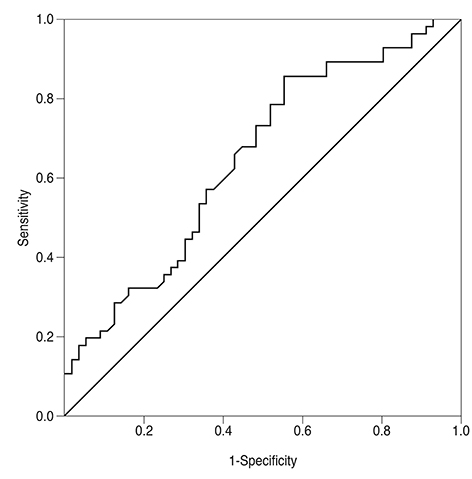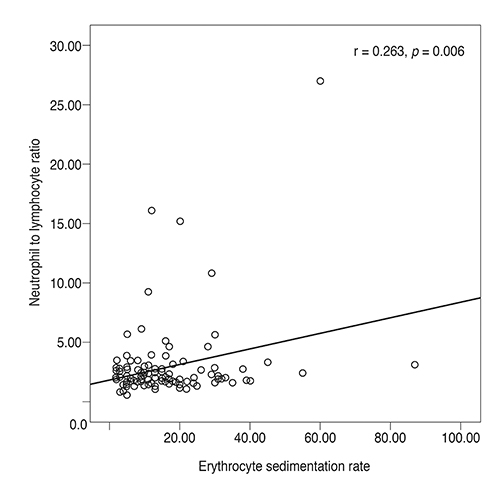Korean J Ophthalmol.
2017 Apr;31(2):159-164. 10.3341/kjo.2017.31.2.159.
Neutrophil to Lymphocyte Ratio in Patients with Nonarteritic Anterior Ischemic Optic Neuropathy
- Affiliations
-
- 1Department of Ophthalmology, Süleyman Demirel University Research and Education Hospital, Isparta, Turkey. dralimesefer@hotmail.com
- KMID: 2373473
- DOI: http://doi.org/10.3341/kjo.2017.31.2.159
Abstract
- PURPOSE
To evaluate the neutrophil to lymphocyte ratio (NLR) in patients with nonarteritic anterior ischemic optic neuropathy (NAION).
METHODS
We investigated 112 subjects comprising 56 patients with NAION and 56 healthy controls at Süleyman Demirel University. Complete blood count, demographic, and clinic data from NAION patients were evaluated in this study. The NLR was calculated in all individuals and compared between the patient and control groups. Cut-off values were also determined. Then, the relationship between NLR and visual outcomes was investigated.
RESULTS
The cut-off value for NLR was 1.64. NLR values were significantly higher in NAION patients than in healthy subjects (p < 0.001) and were directly correlated with erythrocyte sedimentation rate levels (r = 0.263, p = 0.006). Also, the NLR value was associated with visual outcomes. Receiver operator characteristic curve analysis revealed a 0.63 area under the curve (confidence interval, 53.7% to 74.1%), 85% sensitivity and 41% specificity at the cut-off NLR value.
CONCLUSIONS
The NLR may be a biomarker with good sensitivity that is quick, cost effective and easily detected in serum. It can be used in clinical practice to predict a NAION patient's prognosis in terms of visual outcomes.
MeSH Terms
Figure
Reference
-
1. Hattenhauer MG, Leavitt JA, Hodge DO, et al. Incidence of nonarteritic anterior ischemic optic neuropathy. Am J Ophthalmol. 1997; 123:103–107.2. McCulley TJ, Lam BL, Feuer WJ. A comparison of risk factors for postoperative and spontaneous nonarteritic anterior ischemic optic neuropathy. J Neuroophthalmol. 2005; 25:22–24.3. Worrall BB, Moazami G, Odel JG, Behrens MM. Anterior ischemic optic neuropathy and activated protein C resistance: a case report and review of the literature. J Neuroophthalmol. 1997; 17:162–165.4. Arruda-Olson AM, Reeder GS, Bell MR, et al. Neutrophilia predicts death and heart failure after myocardial infarction: a community-based study. Circ Cardiovasc Qual Outcomes. 2009; 2:656–662.5. Azab B, Chainani V, Shah N, McGinn JT. Neutrophil-lymphocyte ratio as a predictor of major adverse cardiac events among diabetic population: a 4-year follow-up study. Angiology. 2013; 64:456–465.6. Ertas G, Sonmez O, Turfan M, et al. Neutrophil/lymphocyte ratio is associated with thromboembolic stroke in patients with non-valvular atrial fibrillation. J Neurol Sci. 2013; 324:49–52.7. Dirican N, Anar C, Kaya S, et al. The clinical significance of hematologic parameters in patients with sarcoidosis. Clin Respir J. 2016; 10:32–39.8. Ahsen A, Ulu MS, Yuksel S, et al. As a new inflammatory marker for familial Mediterranean fever: neutrophil-to-lymphocyte ratio. Inflammation. 2013; 36:1357–1362.9. Dirican A, Kucukzeybek BB, Alacacioglu A, et al. Do the derived neutrophil to lymphocyte ratio and the neutrophil to lymphocyte ratio predict prognosis in breast cancer? Int J Clin Oncol. 2015; 20:70–81.10. Kao SC, Pavlakis N, Harvie R, et al. High blood neutrophil-to-lymphocyte ratio is an indicator of poor prognosis in malignant mesothelioma patients undergoing systemic therapy. Clin Cancer Res. 2010; 16:5805–5813.11. Farah R, Khamisy-Farah R. Association of neutrophil to lymphocyte ratio with presence and severity of gastritis due to Helicobacter pylori infection. J Clin Lab Anal. 2014; 28:219–223.12. Hayreh SS, Zimmerman MB. Nonarteritic anterior ischemic optic neuropathy: natural history of visual outcome. Ophthalmology. 2008; 115:298–305.13. Hayreh SS. Role of steroid therapy in nonarteritic anterior ischemic optic neuropathy. J Neuroophthalmol. 2010; 30:388–389.14. Tesser RA, Niendorf ER, Levin LA. The morphology of an infarct in nonarteritic anterior ischemic optic neuropathy. Ophthalmology. 2003; 110:2031–2035.15. Arnold AC. Pathogenesis of nonarteritic anterior ischemic optic neuropathy. J Neuroophthalmol. 2003; 23:157–163.16. Zhang C, Guo Y, Miller NR, Bernstein SL. Optic nerve infarction and post-ischemic inf lammation in the rodent model of anterior ischemic optic neuropathy (rAION). Brain Res. 2009; 1264:67–75.17. Salgado C, Vilson F, Miller NR, Bernstein SL. Cellular inflammation in nonarteritic anterior ischemic optic neuropathy and its primate model. Arch Ophthalmol. 2011; 129:1583–1591.18. Slater BJ, Vilson FL, Guo Y, et al. Optic nerve inflammation and demyelination in a rodent model of nonarteritic anterior ischemic optic neuropathy. Invest Ophthalmol Vis Sci. 2013; 54:7952–7961.19. Goldenberg-Cohen N, Kramer M, Bahar I, et al. Elevated plasma levels of interleukin 8 in patients with acute anterior ischaemic optic neuropathy. Br J Ophthalmol. 2004; 88:1538–1540.20. Ilhan N, Daglioglu MC, Ilhan O, et al. Assessment of neutrophil/lymphocyte ratio in patients with age-related macular degeneration. Ocul Immunol Inflamm. 2014; 1–4.21. Karaca EE, Ozmen MC, Ekici F, et al. Neutrophil-to-lymphocyte ratio may predict progression in patients with keratoconus. Cornea. 2014; 33:1168–1173.
- Full Text Links
- Actions
-
Cited
- CITED
-
- Close
- Share
- Similar articles
-
- Serum Inflammatory Biomarkers in Patients with Nonarteritic Anterior Ischemic Optic Neuropathy
- The Function of the Fellow Eye in Patients with Unilateral Nonarteritic Anterior Ischemic Optic Neuropathy
- Fluorescein Angiographic Findings of Nonarteritic Anterior Ischemic Optic Neuropathy and Optic Neuritis
- Nonarteritic Anterior Ischemic Optic Neuropathy Simultaneously Associated with Hashimoto’s Thyroiditis
- The Effect of an Intravitreal Triamcinolone Acetonide Injection for Acute Nonarteritic Anterior Ischemic Optic Neuropathy



